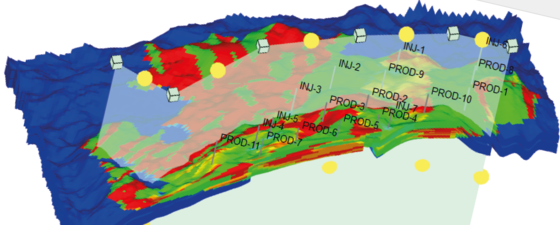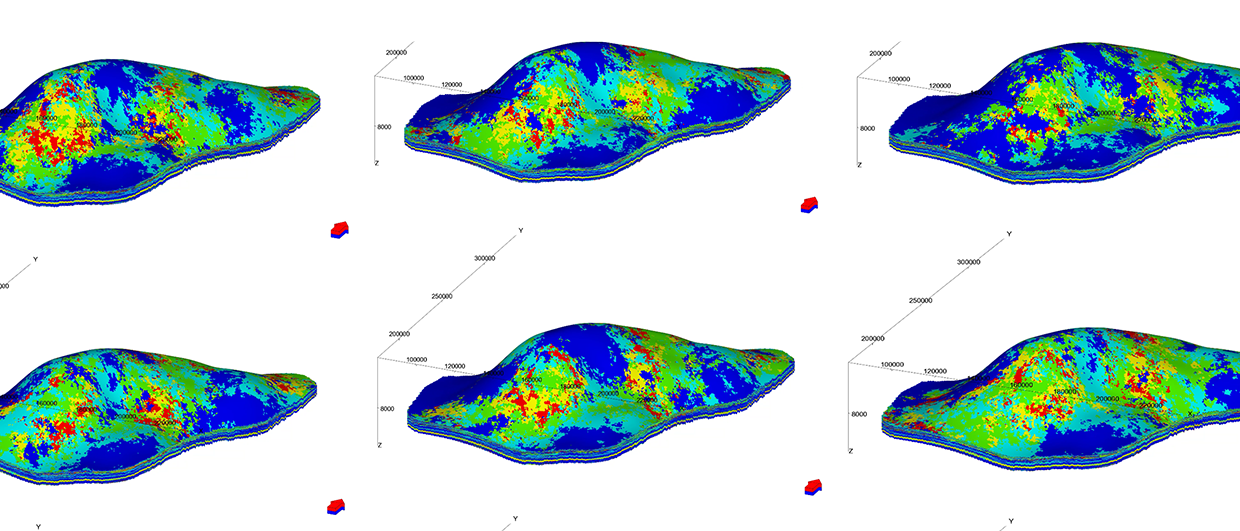Combined optimisation of well control and well placement for the improved production of oil and gas resources.
What is the Olympus Challenge?
The OLYMPUS Field Development Optimisation Challenge was developed by TNO together with ENI, Petrobras, Equinor and Delft University of Technology within the framework of the ISAPP2 (Integrated Systems Approach for Petroleum Production) research consortium, and was launched in early 2017. This challenge is based on the realistic yet fictitious OLYMPUS oil reservoir and consists of three exercises on optimisation under uncertainty: one on well control optimisation, one on well placement optimisation, and one on joint optimisation of well placement and control.
The oil and gas industry is strongly associated with big investments and huge risks; therefore, everyone involved is looking to maximise revenue and minimise risks. Studies show that underestimation of uncertainties – for example, geological uncertainties – can result in unreliable reservoir predictions (Vink et al., 2015). However, modelling uncertainty is very challenging; it requires the generation of multiple models to account for multiple uncertainties, both static and dynamic, which is computationally expensive. Another challenge is the consideration of multiple field development scenarios to optimise field production performance while accounting for multiple geological uncertainties.
The study discussed here looks at well control optimisation under geological uncertainty for a synthetic reservoir model, using the OLYMPUS Field Development Optimisation Challenge data.
To account for geological uncertainties, an ensemble of 50 geological realisations generated by altering the random seed is used (Fonseca et al., 2017). This study looks at how to handle the main limitations of working and handling ensembles of models that are related to workflows, technologies and integration, as well as analysing the enormous quantities of data produced.
High Resolution Geological Model
The main limitations of working and handling ensembles are often thought to be related to workflows, technologies and integration (Ringrose and Bentley, 2015). The common practice to overcome them is to create a very detailed high-resolution geological model that is anchored to a preferred ‘base case’, and this model is then upscaled to be suitable for simulation in a reasonable time. After that, an uncertainty range could be added, either as a percentage factor in terms of the model output (e.g. a percentage of the base case volume inplace) or as separate low and high cases flanking the base case (Ringrose and Bentley, 2015).
Schematic representation of the workflow. Source: Ringrose and Bentley (2015).
The Olympus Well Control Optimisation Challenge presented fifty equally probable geological realisations, the task being to select a single development plan which will be optimal for all 50 realisations. The limitations mentioned above are addressed in this study through a new integrated automated workflow using innovative technologies for model simulations (see figure above). An oil rate (liquid) control for each production well is used, varying from 0 to 900 m3/day, and each injection well is controlled by a surface flow rate target with values from 0 to 1,600 m3/day, which allows the optimiser to decide if a producer or injector should be shut at any given point in time. Well bottom-hole pressures and maximum liquid production rate specified in the exercise description were also included as group constraints.
To perform the well control optimisation study, 360 variables for each ensemble run were defined. Particle Swarm Optimisation (PSO), a stochastic optimiser that explores the parameter space by a population of particles searching for an optimum solution (Eberhart et al., 2001), was used as the optimisation algorithm. It was chosen because it has a small number of parameters to adjust, making it simple in both formulation and computer implementation (Mohamed, 2011). PSO searches for the parameter combinations to maximise the objective function. Net present value (NPV) was set up as the objective function. The following expression was used to calculate NPV:
where R(ti) = Qop (ti ) . rop – Qwp(ti) . rwp – Qwi (ti) . rwi Qop (ti ),Qwp (ti) and Qwi (ti) are total oil production, water production and water injection volumes over the time interval Δti, respectively.
A separate piece of code was developed to allow the running of all 50 geological realisations with the same schedule, launched from a so-called Master.data file. NPV is calculated for each simulation and after the 50 simulations, the mean NPV is calculated, as well as the standard deviation of the ensemble. These figures are used to calculate the objective function value, which is fed to the optimisation part of the workflow, allowing the optimisation algorithm to choose the optimised variables and continue the optimisation loop.
Innovative Technologies for Geological Modelling
In this study, several innovative technologies have been combined to maximise the efficiency of the proposed workflow.
Firstly, optimisation is carried out in the graphical user interface, where a user can select an optimisation algorithm, specify the number of variables and set up the range of each one. Automatic or manual weighting of the objective function can be performed, allowing the user to search and optimise the ensemble in relation to maximising mean NPV or minimising standard deviation (STD), or a combination of both.
Secondly, a link between an ensemble of geological realisations and a schedule file with 360 variables for each simulation run has been created using coding. This both launches the iterations and calculates the objective function of the ensemble. Coding brings in the flexibility; the same code could be altered and used for a different problem set up in a similar manner.
The third innovative technology in this study is cloud computing, used to facilitate computations, as ensemble optimisation requires huge computational power and cloud computing is very efficient at performing such tasks cost-effectively, using powerful external IT resources. Cloud computing is gaining popularity across a variety of industries but the oil and gas industry is showing resistance to this technology due to concerns such as data breach or loss. These concerns can be addressed and minimised by properly researching a cloud provider service, reviewing their security history and references, implementing end-to-end encryption and so on (Parms, 2016).
Unbiased Analysis of Geological Models
Once the limitations related to workflows, technologies and integration have been overcome, the next challenge is how to understand and analyse the enormous quantities of data produced. The main question is: which and how are models selected? How to judge which model is ‘the best’? Working with ensembles might bring the personal preferences or bias of the engineer into the process of analysing results and picking the realisations.
Net Present Value vs Standard Deviation plot; a Pareto front is identified for optimisation of study results. Total field oil production for all 50 model realisations for the low, medium and high cases of NPV vs STD from the Pareto Front are shown in the lower panel.
For example, in this study, if the engineer focuses only on maximising mean NPV, it is quite probable that the standard deviation of the ensemble will also increase. STD can be translated as risk, with higher SD meaning higher risk. If only one result is provided, then an engineer is taking a corporate decision which involves personal preference. It cannot be forgotten that with great power comes great responsibility. To avoid this, the workflow focuses on the generation of an NPV vs STD plot, in which a Pareto front (a set of Pareto optimal solutions, i.e. those that are not dominated by any other feasible solutions) can be identified (see figure below). This can help to assess the multiple solutions against each other and to evaluate the associated risks. Such graphical representation of the results could be included in a project report for management to help them decide how much risk they, as a company, are willing to take for a possible NPV reward.
The spread of total field oil production for the low, medium and high cases of NPV vs STD from the Pareto Front are shown in the figure below, illustrating the impact of uncertainty in the 50 model realisations for three possible scenarios from the Pareto Front.
A Powerful Tool for Optimised Oil and Gas Development Plans
An integrated automated workflow coupled with innovative technologies is a powerful way to perform extensive optimisation tasks whilst accounting for geological uncertainties. The workflow produces an optimised development plan which is ideal for multiple geological realisations. This approach, therefore, can help to undertake a better evaluation of optimal field operating strategies and helps to create an unbiased analysis of the results, taking into consideration risk-reward trade-off.





